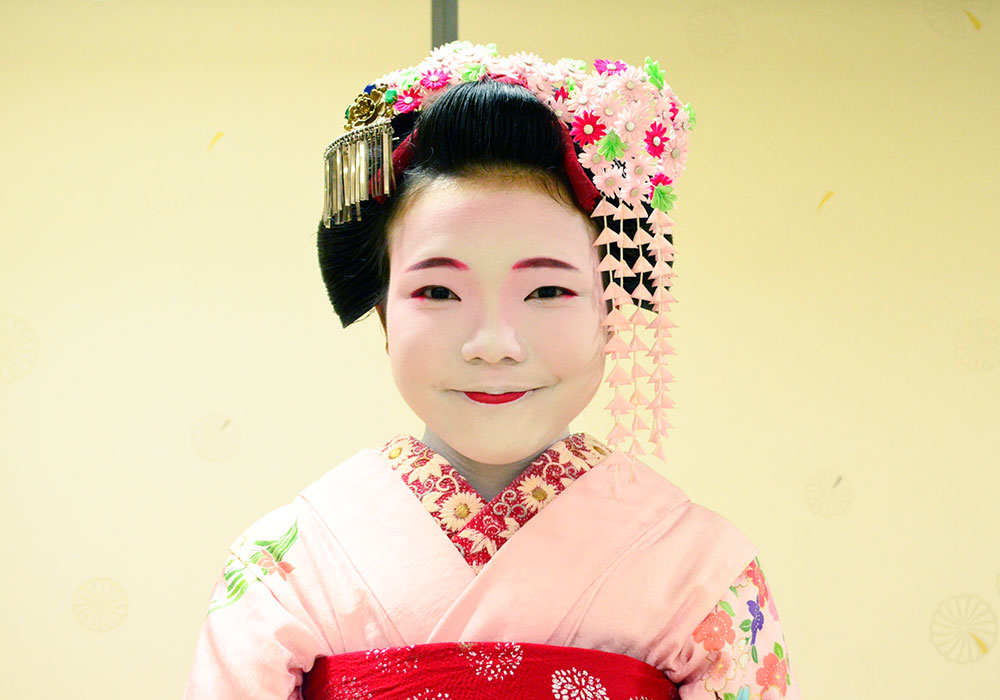What makes Kyoto so special
The history of Kyoto is just more than 1200 years old and is not one of showoffs and curiosity seekers. Many cultures are matured over those centuries. The world has changed, but Kyoto has not. Well, we should say that we have not reached the real deal yet. The common delights in the region's four seasons enriched our cultures. A person like myself who lives in Kyoto for about four years, but still enjoys new discoveries and its depth in culture. Perhaps a tradition that never changes is the foundation of Kyoto culture. We would like to welcome you to the journey of Maiko in our blog. As I mentioned that not every Kyoto resident has mastered every nicety of correct procedure, but most know how to enjoy the cultural pastime so deeply rooted in local life. The Gion district, Kyoto city's most famous Geisha quarters.

Kagai, literally translated as "Flower Town" is the term Kyoto People use for the districts where the Geiko and Maiko practice the high-class arts that have made their beauty and refinement legendary to the world. There are six Kagai in Kyoto: "Gion Kobu", "Miyagawacho", "Pontocho", "Kamishichiken" "Gion Higashi" and "Shimabara". The first five of these Kagai (not including Shimabara) are known as Kyoto's Gokagai (Five Flower Towns).
What is Maiko? Geisha? Geiko?
In Kyoto, apprentice period is called "Maiko". In Kanto, it is called "Hantama" or "Gozukin".In the Kansai region, Geiko is called "Geiko", but in other regions it is called "Geisha". For modern children who have grown up spoiled, working as a Maiko unimaginably requires patience and training. Before officially hiring a Maiko, they live together for a week or so to experience her training.
Mistery of Maiko
What is your impression of Maiko? The visitor may come upon the sight of young women wrapped in brightly colored kimonos with long sleeves that fall nearly to their ankles, and wide-waisted sashes hanging down to the backs of their knees. However it is just appearance, there are so many surprising facts about Maiko.

Maiko's hairstyle is tied with her natural hair, and she goes to a barber every 5 to 7 days to get her hair done. There are only three barbers in Kyoto that can prepare hair for Maiko. The hair is kept tied up when Maiko goes to bed, so she sleeps with a box pillow called an "Omakura," which is about 15 cm high, placed on her neck.
Before World War II, a Maiko's training started around the age of 12. Today Maiko's training begins when she is about 16 years old after she has finished her compulsory education. Around the age of 16 to 20 years old, they devote their whole life to becoming Maiko. If they are recognized by the Okiya (Geisha House) proprietress or association, they will hold a ceremony called "Hakama-Ae" (changing of Hakama belt) and become a Geiko. After making her debut as a Geiko, she is registered with the Okiya and goes to the Ozashiki (dinner party at Tatami room) to serve customers and perform her art.

Maiko's signature
As I mentioned wide-waisted sashes hanging down to the backs of their knees and it has a crest of Okiya. The main reason is said that in the old days, when there was a really young Maiko, even if she gets lost, other Maiko would be able to find the Maiko from which Okiya she was from and return to her Okiya properly. The wide-waisted sashes are about 6 to 7 meters long (20 to 22 feet) and its weight is 6 kg (13 lb). One of the significant features is their makeup. If you look at Maiko's lips, you will find that in the first year, Maiko has bottom of her lip only colored and after the second year, the lips are colored.
Dedication and Professions
They generally begin their apprenticeship at age of 16. And certainly, no one is forced into the profession. As a professional entertainer, Maiko lives fully up to her name, the meaning of which is "Artist." She dedicates her life to excellence in such traditional art as the tea ceremony classical dance, and playing of drums, Shamisen (a type of lute), and other traditional instruments. Maiko is expected to be a gifted and tireless conversationalist. About 5 years of hard training are required to become proficient enough.

Daily life of Maiko
I have already mentioned that their whole life needs to be dedicated to training. They are prohibited to go to convenience stores, fast food like McDonald's, even movie theaters, and Karaoke. Here is some of the regular schedule for Maiko. Each Okiya (Maiko house) has their own rule, however, they wake up around 8 o'clock and from 10 to 1 for training, after lunch, Maiko start make-up and dressing up with Kimono. They head to the Ozashiki (dinner party in Tatami room) and perform dances and serve drinks, and finally return to the Okiya at around midnight and go to bed at around 2:00 at night.

How was Maiko's life? In this blog, we focused on Maiko's life from an interesting point of view. Maiko's life is like the life of a top athlete or even tougher because age of 16 to 20 are full of curiosity and temptation, but prohibited to go to fast food, movie theater, and even Karaoke. Can you give up all for to become the Maiko or any path you are interested in? I surely can not accept a harsh environment. Learning about Maiko is not only getting more knowledge but also giving us the importance of respect. Maiko is not just performing dances and serving drinks, of course, they are professionals who heal their guests and show the highest level of hospitality.

